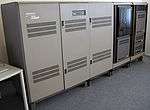History of computer hardware in Soviet Bloc countries
| History of computing |
|---|
| Hardware |
| Software |
| Computer science |
| Modern concepts |
| Timeline of computing |
|
The history of computing hardware in the former Soviet Bloc is somewhat different from that of the Western world. As a result of the CoCom embargo, computers could not be imported on a large scale from capitalist countries. All computer hardware produced in Socialist countries were designed locally.[1] This redevelopment led to some incompatibilities with International Electrotechnical Commission (IEC) and IEEE standards, such as spacing integrated circuit pins at 1⁄10 of a 25 mm length (colloquially a "metric inch") instead of a standard inch of 25.4 mm.[2] This made Soviet chips unsellable on the world market outside the Comecon, and made test machinery more expensive.[3]
Soviet computers
Large computers
BESM
BESM (БЭСМ) is the name of a series of Soviet mainframe computers built in the 1950s and 1960s. The name is an acronym for "Bolshaya Elektronno-Schyotnaya Mashina" ("Большая Электронно-Счётная Машина"), literally "Large Electronic Computing Machine". The series began as a successor to MESM, the first stored-program computer in the Soviet Union. While one MESM was built, some 250 BESM-6 machines were delivered. They were less advanced, for their timeframe, than the MESM was in its time.[4]
ES EVM
ES EVM (ЕС ЭВМ, Единая система электронных вычислительных машин, meaning "Unified System of Electronic Computers") was a series of clones of IBM's System/360 and System/370 mainframes, released in the Comecon countries under the initiative of the Soviet Union starting in the 1960s. Production continued until 1998. The total number of ES EVM mainframes produced was more than 15,000.
In the period from 1986 to 1997, a series of PC-compatible desktop computers, called ПЭВМ ЕС ЭВМ (Personal Computers of ES EVM series), was also produced; the newer versions of these computers are still produced under a different name on a very limited scale in Minsk.
MESM
The first universally programmable electronic computer in continental Europe was created by a team of scientists under the direction of Sergei Alekseyevich Lebedev from the Kiev Institute of Electrotechnology in the Soviet Union, at Feofaniya.[5] The computer was known as MESM (МЭСМ, Малая Электронно-Счетная Машина, Small Electronic Calculating Machine), and became operational in 1950.[4] It had about 6,000 vacuum tubes and consumed 25 kW of power. It could perform approximately 3,000 operations per minute.[6] It was 8 to 10 meters long and about 2 meters tall.[7]
ELBRUS
Elbrus (Russian: Эльбрус, named after Mount Elbrus) is a series of Soviet supercomputer systems developed by the Lebedev Institute of Precision Mechanics and Computer Engineering (ITMiVT) since the 1970s. Since the 1990s, the development continued by MCST (Moscow Center of SPARC Technologies, ru:МЦСТ), a spin-off of the ITMiVT.
Nairi
The first Nairi (computer) was developed and launched into production in 1964, at the Yerevan Research Institute of Mathematical Machines (Yerevan, Armenia). In 1965, a modified version called Nairi-M, and in 1967 versions called Nairi-S and Nairi-2, were developed. Nairi-3 and Nairi-3-1, which used integrated hybrid chips, were developed in 1970.
Strela
The Strela computer, 1953–1956, used 43-bit floating point words, with a signed 35-bit mantissa and a signed 6-bit exponent.
Seven Strelas were manufactured in Moscow by a factory in the Ministry of Instrument Making and Automation Means of the USSR; they were the primary debugging platforms for computing, and the most productive computers in the Soviet Union during this period. Strelas could process 2000 instructions per second. The last version of Strela used a 4096-word magnetic drum, rotating at 6000 rpm.
Other computers include BESM-6, Ural, Setun, ES EVM, Minsk, and Elbrus.
Workstations
Some workstations built in the Soviet Union were the Besta-88, DVK and 18xx models ES series.
Personal and home computers
Personal computers include the Agat computer, Korvet, Elektronika BK, UKNC, Mikrosha, Raduga, Poisk, Iskra, Irisha, various clones of ZX Spectrum (i.e. Dubna 48K) and IBM PC/XT, many other models.
Micro-80
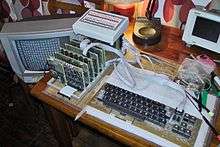
- Main article: Микро-80
The Micro-80 was the first do-it-yourself home computer in the Soviet Union. Schematics and information were published in the local DIY electronic magazine Radio in 1983. It was complex, using an KR580VM80A-based system (a clone of the Intel 8080) which contained about 200 ICs. This system gained low popularity, but set a precedent in getting the attention of hobbyists for DIY computers, and later other DIY computers were published by Radio and other DIY magazines.
Radio-86RK
- Main article: Радио 86РК
The Radio-86RK was the second DIY computer featured in Radio magazine, in an edition published in 1986. It was more popular than the Micro-80 because it was much simpler (29 ICs, i8080 @1.78 MHz with i8257 and i8275-based CRT terminal). Many factories started production of home computers based on this design (such as the Apogey BK-01, Mikrosha, Krista, Partner 01.01, and the Spektr-001). These computers had limited compatibility with the original software, although their schematics were very close to the original.
Specialist
The "Specialist" was the first DIY computer which was published in a magazine other than Radio; it was published in Modelist-Konstructor, a DIY magazine which was not exclusively focused on electronics. The computer was named the Specialist, and the magazine detailing its specifications was published in 1987, although it was developed by one hobbyist two years earlier. It was much more advanced than previous DIY computers, because it had a higher graphical resolution (384x256) and a "transparent" video system, which did not slow down the CPU when both the CPU and the video system tried to access the RAM simultaneously. It gained limited popularity with hobbyists, though some factories produced DIY kits (Lik for example).
UT-88
- Main article: ЮТ-88
Yunij Technik (Young Engineer) magazine released details for one DIY home computer, the UT-88, which was published in 1988. It was a step back to the Micro-80 conception but was much simpler and used very widespread elements, which made it available for less skilled hobbyists. It was divided into a few blocks, starting from a single-board microcomputer with LED display and HEX keyboard, and later adding more RAM, TV interface, and complete keyboard.
Orion-128
The Orion-128 was the last DIY computer published in Radio magazine and the last Intel 8080-based DIY computer in Russia. It used the same concepts as the Specialist and had similar specifications, with both advances and flaws. It gained more popularity because it was supported by a more popular magazine, though it was never produced by factories in any form. Much of the software for the Orion-128 was ported by hobbyists from the Specialist and the ZX Spectrum.
Vector-06C
One of the last Soviet-designed, 8-bit home computers was the Vector-06C with an i8080 CPU clone which ran at 3 MHz, which is still used by some enthusiasts. It had color graphics (16 colors) with programmable palette and few resolutions. Some games were ported from MSX and ZX Spectrum computers (converting original code from Z80 to 8080 and replacing graphics output code).
Belarusian computers
From 1959 to 1975, several types of general-purpose computers were developed in Belarus. These machines had become a basis for the Soviet fleet of computers, and their large-scale production was organized.
The "Minsk" family of computers Minsk 1, 2, 3 etc. are Soviet mainframe computers of the 1960s, which compared very well with their Western analogs. At the end of the 1960s, Soviets started manufacturing the IBM-compatible computers in Minsk, and later Brest, Belarus. These computers were known as EC-1020, EC-1022, EC-1035, EC-1036, EC-1130. The EC-1060, EC-1061 and EC-1066 computers, developed in Moscow, were also manufactured in Belarus. The EC-1840,1841, 1842, 1863 – analogs of IBM PC – were developed in Belarus in the 1980s. In 1988, Belarus produced its first laptop.[8]
Estonian computers
Juku
Juku ES101 is a personal computer based on the KR580VM80A CPU (a Soviet clone of the Intel i8080A) that was released in 1988 and was produced in Narva, Baltijets, till the collapse of the Soviet Union. The target market for the Juku was schools and in 1991 many, if not all, bigger (at least 100 pupils) Estonian schools had a computer classroom that was furnished with those machines. Despite their wide availability, their use in practical office work was severely limited due to lack of end user skills and the shortage of computer professionals, who could have trained the end users.
Lithuanian computers
- Main article: Vilniaus skaičiavimo mašinų gamykla
Vilniaus skaičiavimo mašinų gamykla was computer and their component manufacturer (since 1957), developer (Skaičiavimo mašinų specialus konstravimo biuras), which in 1966 became part of industrial group SIGMA. 1960–1965 EV80-3M, which was developed in Moscow, it was only assembled; 1964–1967 EASP-S, first developed computer; 1964–1974 EVP80-2 Rūta, based on discrete transistors; 1964–1970 ATE80-1, developed in Moscow, only assembled; 1969–1972 Rūta-110, which had handwritten OCR capability with Rūta-701; 1973–1979 M5000, minicomputer; 1975–1981 M5010; 1978–1984 M5100; 1982–1988 SM 1600, (one processor was PDP-11/34 clone); 1986–1990 SM 1700, (VAX-11/730 clone).
Nuklonas was integrated circuit manufacturer since 1966, which also produced PC computers and their integrated circuits BK-0010 (discontinued in 1992).[9]
East German computers
 Robotron A 5120 office computer, 1982 |
 KC 85/4 home computer, 1987 |
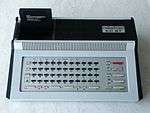 Robotron KC 87 home computer, 1987 |
 Robotron A 7100 and EC 1834 (XT-compatible) personal computer, 1986 |
VEB Robotron and ESER
In East Germany (German Democratic Republic), the main manufacturer of computer hardware was VEB Robotron. They were involved in the ESER (ES EVM) and SKR (SM EVM) development of a standard across Comecon countries.
VEB Kombinat Mikroelektronik
Another important Kombinat beneath Robotron was the Kombinat Mikroelektronik Erfurt. It manufactured integrated circuits—e.g. microprocessors U880 (Z80-clone), U80601 (80286-clone) and U80701 (MicroVAX 78032-clone)—and also some series of home computers (KC85/2-KC85/4).
Polish computers
 XYZ, 1958 |
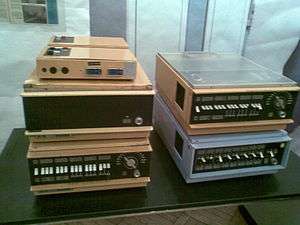 K-202, 1971 |
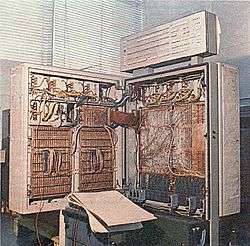 Odra No. 1305, 1974 |
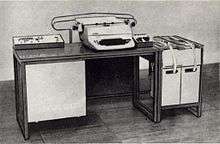 MERA 302, 1974 |
Odra
Some of the earliest computers created in Poland were the first Odra computers. They were manufactured at the Elwro manufacturing plant in Wrocław, (the brand name comes from the Odra River that flows through the city of Wrocław) and exported to other communist countries. The production started in 1959–1960.
The last series of Odra computers—the Odra 1300—consisted of three models: the Odra 1304, 1305, and the 1325. Although the hardware was developed by Polish teams, the software for the above machines was provided by the British company ICL (that is, the Odra was ICL 1900 compatible).
K-202
K-202 was 16-bit minicomputer built by Jacek Karpiński in 1971. It was faster and cheaper than most of the world's production at this time, and more advanced than IBM PC released decade later, but the production was never started because of political reasons and dependence on western parts; it was not compatible with the ES EVM standard.
Meritum
Produced by Mera-Elzab, Meritum I and II models were created in 1983 and 1985 respectively. Based on U880DA CPU (Zilog Z80 clone), with 16 and 48KB RAM, were based on the TRS-80 computer. They were intended primarily for scientific, engineering and office applications.
Elwro Junior
Elwro 800 Junior (1986) and Elwro 804 Junior (1990) were ZX Spectrum clones intended for schools, and for home use respectively. The 804 model had a 3.5" disk drive built in; the drive was available as an accessory for 800 (the alternative mass storage being a tape recorder). The computers used the Z80A CPU, 64KB RAM and 16KB ROM. The ROM contained either CP/J (a variant of CP/M) operating system, or Spectrum-compatible BASIC. [10][11]
Mazovia
Mazovia was a Polish clone of IBM PC/XT.
Bulgarian computers
In the 1980s, Bulgaria manufactured computers according to an agreement within the COMECON:
- Mainframes: IZOT series and ES EVM series (abbreviation from Edinnaya Sistema Elektronno Vichislitelnih Machin, or Unified Computer System — created in 1969 by USSR, Bulgaria, Hungary, GDR, Poland and Czechoslovakia).
- Personal computers: IMKO, Pravetz-82/8M/8A/8E/8C/8D — an 8-bit machine (Apple II clone), based on Bulgarian-made 6502 variants, Pravetz-16/16A/16H/286 (16-bit) — IBM PC clones based on i8088(V20)/286.
- Personal Computers: IZOT 1030 — based on East German-made U880 (a Z80A clone), IZOT 1036C -IBM PC compatible based on i8086, IZOT 1037C - IBM PC/XT clone based on i8088,
For example, the Pravetz-8M featured two processors (primary: Bulgarian-made clone of 6502, designated SM630 at 1.018 MHz, secondary: Z80A at 4 MHz), 64 KB DRAM and 16 KB EPROM.
The largest computer factory was some 60 km (37 mi) from Sofia, in Pravetz. Another big facility was the plant "Electronika" in Sofia. Smaller plants throughout the country produced monitors and peripherals, notably DZU (Diskovi Zapametyavashti Ustroistva — Disk Memory Devices) — Stara Zagora made hard disks for mainframes and personal computers.
At its peak, Bulgaria supplied 40% of the computers in COMECON. The electronics industry employed 300,000 workers, and it generated 8 billion rubles a year (US$13.3 billion). Since the democratic changes in 1989 and the subsequent chaotic political and economic conditions, the once blooming Bulgarian computer industry almost completely disintegrated.
Romanian computers
The history of Romanian computers is described here (in Romanian, for the moment).
The Romanian computers HC family (HC 85, HC 85+, HC 88, HC 90, HC 91 and HC 2000) were clones of Sinclair ZX Spectrum that were produced at ICE Felix from 1985 to 1994. HC 85 was first designed at Institutul Politehnic București by Prof. Dr. Ing. Adrian Petrescu (in laboratory), then redesigned at ICE Felix (in order to be produced at industrial scale). Their operating system was a BASIC interpreter.
aMIC (microcomputer) was a Romanian microcomputer designed by Prof. Adrian Petrescu at Institutul Politehnic București in 1982, later produced at Fabrica de Memorii in Timișoara.
MARICA and the DACICC family (DACICC-1 and DACICC-200) were Romanian computers produced in 1959-1968 at T. Popoviciu Institute of Numerical Analysis, Cluj-Napoca.
Felix PC was a Romanian IBM-PC compatible produced at ICE Felix in 1985-1990.
CoBra was a Romanian personal computer produced at I.T.C.I Brașov, in 1986.
Felix C was a family of Romanian computers produced by ICE Felix from 1970 to 1978. They were similar to IBM/360; their operating system was SIRIS.
Felix M was a family of Romanian mini and microcomputers in 1975-1984.
Independent minicomputer series was a series of Romanian minicomputers, manufactured from 1983 to 1989. They were compatible with DEC-PDP 11-34, running RSX-11M operating system. They were produced at ITC Timișoara, with memory chips also produced in Timișoara.
See also
- History of computer hardware in the Socialist Federal Republic of Yugoslavia
- History of computing hardware
- List of Soviet computer systems
- List of Soviet hardware engineers
- BESM
- HRS-100 – a hybrid computer jointly designed by engineers from USSR and Mihajlo Pupin Institute and deployed in Russian Academy of Sciences in 1971
References
- ↑ Weiss, Gus W. (1996), "The Farewell Dossier: Duping the Soviets", Studies in Intelligence, Central Intelligence Agency
- ↑ Deza, Michel, Encyclopedia of Distances, Google eBooks, p. 497
- ↑ Fred Langa, "An Editor's View" sidebar to "Computing in the U.S.S.R.", April 1991 BYTE Magazine, page 129
- 1 2 Graham, Loren R. (1993). Science in Russia and the Soviet Union: A Short History. Cambridge University Press. p. 256. ISBN 0521287898.
- ↑ Reliable Software Technologies - Ada-Europe '99: 1999 Ada-Europe International Conference on Reliable Software Technologies, Springer Science+Business Media, 1999, ISBN 3540660933 (page 181)
- ↑ Crowe, Gregory D.; Goodman, Seymour E. (1994), "S.A. Lebedev and the Birth of Soviet Computing" (PDF), Annals of the History of Computing, Institute of Electrical and Electronics Engineers, 16: 4–24, doi:10.1109/85.251852
- ↑ Electronic Brains, by Mike Hally, 2005, ISBN 978-0-309-09630-0, p. 145
- ↑ Integral
- ↑ Telksnys, Laimutis; Žilinskas, Antanas (1999). "Computers in Lithuania" (PDF). IEEE Annals of the History of Computing. 3 (21): 31–37. doi:10.1109/85.778980. ISSN 1058-6180.
- ↑ Elwro 800 Junior PC on Starekompy.pl
- ↑ Elwro 804 Junior PC on Starekompy.pl
External links
- Soviet calculators and computers collection by Sergei Frolov
- Pioneers of Soviet Computing
- Museum of Soviet Arcade Machines at the Moscow State Technical University.
- Bulgarian Computers
- Bulgarian Computers Information File
- Steal The Best, a micrograph of a Digital Equipment Corporation CVAX microprocessor used in the MicroVAX and VAX 6200 systems. It contains "VAX — when you care enough to steal the very best" translated in broken Russian as a message to Soviet reverse engineers.
- Soviet Block computers with references to Romania
- Computing in East Germany (in German)
- Juku
- List of Soviet Russian made CPUs and support chips
